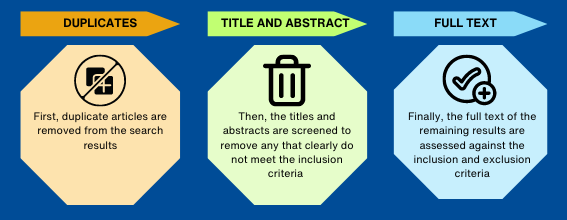Screening
Learning Objectives
This chapter will help you:
- understand the importance of a reproducible and systematic screening process.
- screen articles found in a search.
- use reporting guidance to report your screening.
“Decisions about which studies to include in a review are among the most influential decisions that are made in the review process and they involve judgment” (Lefebvre et al., 2022, s. 4.6.4.).
Once you have completed your search, you need to systematically select the articles relevant to your review question. This is called screening which is a systematic way to reduce the chance of missing relevant ones or including those that do not meet your protocol’s inclusion criteria. It also reduces the risk of personal bias influencing decisions by reporting and explaining what you did and why, which helps your review to be replicable and reliable.
Screening process
There are three steps to screening your results.

It is advisable to test the screening first with approximately six articles to test the validity of the inclusion and exclusion criteria. This also helps to maintain consistency between team members as they become familiar with the process (Lefebvre et al., 2022).
You should also remember some studies are reported in journals, registries or conferences several times. Track these other versions down because they may include different data and information. Lefebvre et al. (2022) suggest two approaches to this:
- Link multiple versions together. The Cochrane Handbook has instructions on how to identify multiple reports from the same study.
- Evaluate the information in each report separately to decide if they meet inclusion criteria.
Removing duplicates
The first step of screening is to remove duplicate records from your results, as the same records may be found in multiple databases. Screening can be a lengthy process, and you don’t want to screen the same article multiple times! This can be made easier by using reference management software such as EndNote or Zotero.
Title and abstract
After duplicates are removed, conduct an initial screening by looking at titles and abstracts to exclude any that do not meet the inclusion criteria. At least two members of the team screen each article independently with disagreements resolved by discussion or a third reviewer (Porritt et al., 2014). You do not need to record reasons for excluding articles at this stage, but you do need to record how many were excluded and how many were left. You need to make one of the following decisions:
- yes: The article looks relevant and will move to the full-text screening.
- no: The article is irrelevant and is excluded.
- maybe: You aren’t sure or there is not enough information in the title and abstract to decide. It will move to the full-text screening.
Activity 12
Full text
In the next stage, you look at the full text for each remaining article and assess it against the inclusion and exclusion criteria. These are independently screened by at least two reviewers with disagreements settled by discussion or another team member (Caldwell & Bennett, 2020; Tawfik et al., 2019). You need to record the reason for exclusion and how many were excluded for each reason. These will relate to your inclusion and exclusion criteria, such as the wrong population.

If you are unable to find the full text of an article, there are several ways you can try and access it.
- Ask your institution’s library if they can access it using document delivery.
- Contact the authors or their institution and request a copy.
- Search online or through Google Scholar to see if an open-access version is available.
You will then decide:
- yes: The article meets the inclusion criteria and will included in the review.
- no: The article does not meet inclusion criteria and will not be included in the review.
Example
Click on the accordion buttons to see the screening process and the inclusion criteria of the following systematic review.
Sullivan, O., Curtin, M., Flynn, R., Cronin, C., Mahony, J. O., & Trujillo, J. (2024). Telehealth interventions for transition to self-management in adolescents with allergic conditions: A systematic review. Allergy, 79, 861-883. https://doi.org/10.1111/all.15963
Reporting
During all stages of screening, keep records of your decisions to ensure transparency and replication of the review in the future (Page et al., 2021). Documenting decisions is crucial when reporting on the screening process in a PRISMA flow diagram.
The PRISMA flow diagram shows how you ended up with the final included articles. It documents how many results you found in the search, how many were included and excluded, and why. If you are using software such as Covidence, this will be created automatically. You can also use a word processing program to create one yourself.
Activity 13
This short video by Research Masterminds explains the PRISMA flow diagram in more detail and describes tools that can help you create one.
Research Masterminds. (2021, May 28). The PRISMA 2020 flow diagram: What is it all about? [Video]. YouTube. https://youtu.be/IgYqlv71l6g
Further reading
Tsafnat, G., Glasziou, P., Karystianis, G., & Coiera, E. (2018). Automated screening of research studies for systematic reviews using study characteristics. Systematic Reviews, 7, Article 64. https://doi.org/10.1186/s13643-018-0724-7
References
Caldwell, P. H. Y., & Bennett, T. (2020). Easy guide to conducting a systematic review. Journal of Paediatrics Child Health, 56(6), 853-856. https://doi.org/10.1111/jpc.14853
Lefebvre, C., Glanville, J., Briscoe, S., Featherstone, R., Littlewood, A., Marshall, C., Metzendorf, M.-I., Noel-Storr, A., Paynter, R., Rader, T., Thomas, J., & Wieland, L. S. (2022). Chapter 4: Searching for and selecting studies. In J. P. T. Higgins, J. Thomas, J. Chandler, M. Cumpston, T. Li, M. J. Page, & V. A. Welch (Eds.), Cochrane handbook for systematic reviews of interventions (version 6.3). Cochrane. https://training.cochrane.org/handbook/current/chapter-04
Page, M. J., McKenzie, J. E., Bossuyt, P. M., Boutron, I., Hoffmann, T. C., Mulrow, C. D., Shamseer, L., Tetzlaff, J. M., Akl, E. A., Brennan, S. E., Chou, R., Glanville, J., Grimshaw, J. M., Hróbjartsson, A., Lalu, M. M., Li, T., Loder, E. W., Mayo-Wilson, E., McDonald, S., . . . Moher, D. (2021). The PRISMA 2020 statement: An updated guideline for reporting systematic reviews. Journal of Clinical Epidemiology, 134(71), 178-189. https://doi.org/10.1016/j.jclinepi.2021.03.001
Porritt, K., Gomersall, J., & Lockwood, C. (2014). JBI’s Systematic Reviews: Study selection and critical appraisal. American Journal of Nursing, 114(6), 47-52. https://doi.org/10.1097/01.Naj.0000450430.97383.64
Tawfik, G. M., Dila, K. A. S., Mohamed, M. Y. F., Tam, D. N. H., Kien, N. D., Ahmed, A. M., & Huy, N. T. (2019). A step by step guide for conducting a systematic review and meta-analysis with simulation data. Tropical Medicine and Health, 47(1), Article 46. https://doi.org/10.1186/s41182-019-0165-6
Qualifications and disqualifications for retrieved results.
A database for the publication of information about the design, conduct and administration of research.
A program that helps create and manage records of literature.

